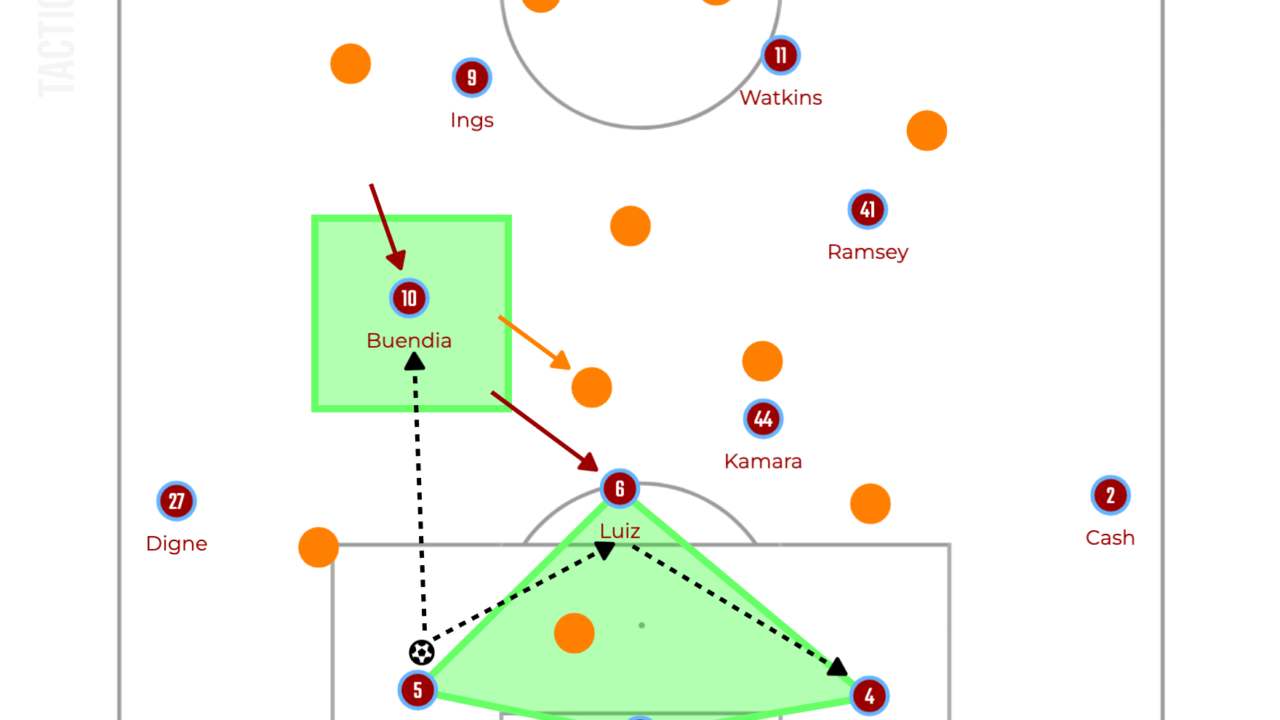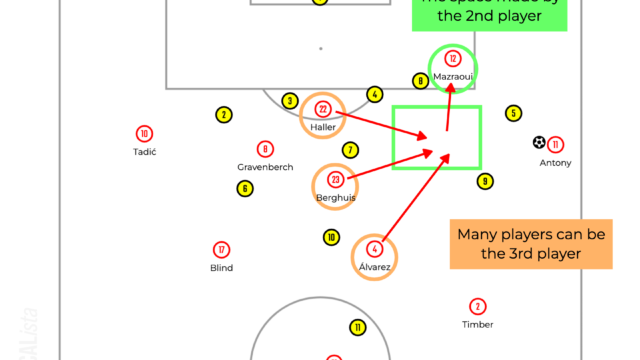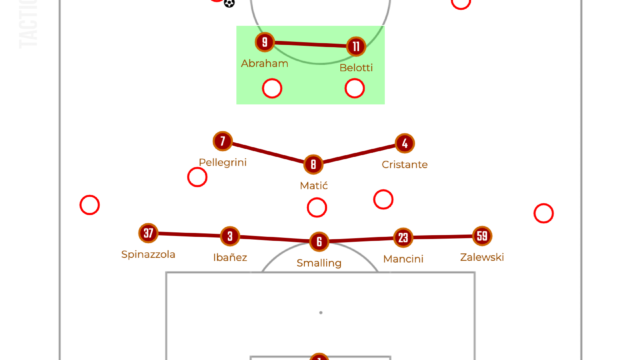Introduction
In this article, the tactics of Aston Villa, who appointed Unai Emery as a new manager, are going to be analysed. They have played only three games including two games against Manchester United after the Spaniard took over the team, but the basic idea of Emery was already found on the pitch. In possession, they try to play short passes to drag the opponents out and exploit the space in behind them quickly with four attackers. Then, out of possession, the back line is set extremely high to press aggressively and force the opponent to play long roughly. Sometimes their defensive line is described as ‘six back’, but it is not because a defensive reason but an aggressive reason. Overall, new Aston Villa attack with maximising the depth of the pitch and defend with minimising the depth of the pitch. Let’s get started with analysing their build up tactics.
Build up
The purpose of build up play for Aston Villa or Unai Emery is not keeping the possession but pulling the opposition players out by inviting high pressure. Therefore, how to use the space vacated by the opponents who are dragged out is the most important factor in this phase.
First of all, the system of build up is shown in the illustration below.

The original system is usually a 4-4-2 but it does not look an ordinary 4-4-2. When playing out from the back, both wide midfielders are positioned within the width of the box. They are the key players because the objective of playing out from the back is creating a space to play to attackers up front and the wide midfielders are the main players to receive the split passes.
Before analysing the movement of attackers, how to keep the possession under the opposition pressure at the back is discussed.
Both centre backs positioned themselves deeply next to the goalkeeper to drag the opposition attackers out. Additionally, one of the defensive midfielders drops towards the D and creates a diamond shape at the back. Douglas Luiz mainly does this job but Boubacar Kamara or Leander Dendoncker can also manage this role.
There are two reasons of creating this diamond shape.

The first objective is offering a passing lane from the centre back on the ball and playing it to the other centre back to keep the possession. If the opposition striker presses to the centre back with cutting the passing lane to the goalkeeper or other centre back, the centre back will be forced to play it long. However, if one of the defensive midfielders drops to receive the ball, it is possible to switch the ball to the other side by using the defensive midfielder as a third player. The movement that the defensive midfielder drops to receive the ball is important especially when the opponent tries to mark him from his back because this allows the defensive midfielder to receive the ball away from the pressure and play it backwards with a first time pass safely.
The second reason is more important. If the defensive midfielder dropping back can drag his marker out of his position, there will be a space for the wide midfielder to receive the ball in between the lines. This is the trigger to change the tempo and play fast attacks which look like counterattacks with four attackers. Additionally, this is what Emery wants to create by playing out from the back.
Then, how four attackers can receive the ball in between lines and play fast attacks are going to be analysed.
Usually, two strikers pin the opposition centre backs and two wide midfielders position themselves in between lines within the width of the box. However, if Emi Buendía plays as one of the strikers, he is also positioned in between lines, which means a striker up front and three attackers in between lines. However, the common and interesting thing is the narrow position of wide players. Therefore, the tactical reason of this is going to be analysed.
Recently, it is popular that wingers give the maximum width to make the pitch big when building up. However, Emery’s approach is the opposite. The wide players come inside and there are no players where wingers originally are. This unique position of wide players can confuse the opposition fullbacks.

If the fullback keeps marking the wide player, he will vacate a space in behind. Actually, when the centre back on the ball is under the pressure, he plays long into the space and the striker drifts wide to use the space. However, if the fullback stays on the back line to cover the space in behind, the wide player in between the lines has time and space enough to receive the ball and turn. It is obvious that split passes on the ground is much more accurate than long balls in the air, so the latter one is the better situation for Villa.
In order to create better situations, when the wide player is about to receive the ball, the ball side striker drifts wide to pin the fullback.

Thanks to the movement of the striker, the wide player can receive the ball and turn easily. Additionally, as one of the strikers is now in the wide channel, the wide player on the ball can have two options to play. In this kind of situation, it is difficult for the opposition defenders to jump to press because it makes easier for the player on the ball to play through passes. Therefore, the wide player on the ball can progress the ball into the final third comfortably.
Another advantage of the narrow position of the wide players is the fullback can use the wide area where nobody is.

The first option is that the goalkeeper clips the ball over the opposition winger’s head to the fullback. This is often used when Martínez is pressed by the opposition striker and the fullback usually receives the ball is the left fullback, Lucas Digne. If nobody presses to the fullback, he can progress the ball because there are no players in the wide lane. However, even if the opposition fullback jumps to press to the fullback, there is still a way to progress the ball. As the opposition fullback presses to the fullback, the wide player in between lines becomes available. It is impossible for one of the opposition centre backs to step up to presses to the wide player because he is pinned by the striker. Additionally, it is a tough job for the opposition defensive midfielder to shuffle across to mark the wide player and if the opposition attacking midfielder drops back, Villa’s defensive midfielder becomes available.
Another way is the fullback receiving the ball laid off by the wide player. The best situation is that the wide player can receive the ball in between lines and progress it forwards. However, if the opposition fullback can mark the wide player tightly, it is difficult for the wide player to turn. In this situation, the fullback can offer a safe passing lane and progress the ball because there is no one in front of him.
In short, thanks to the narrow position of wide players, the fullbacks can have a space to progress the ball forwards.
So far, the tactics of build up was discussed. In the next chapter, how to score goals after progressing the ball into the final third is going to be analysed.
Final Third Attacking
As it was discussed in the previous chapters, Aston Villa’s main tactic is attacking quickly. They create fast attacks which look like counterattacks by inviting the opposition high pressure. Therefore, they can penetrate the box with a few numbers of players against a few number of defenders. This is more effective because each player can have more space in the box where even the space of the size of the ball can be crucial.
As it was mentioned above, the main way of progressing the ball into the final third is that one of the wide players or fullbacks carries the ball while the ball side striker drifts wide. After that, the player on the ball can deliver a cross or play outside to the striker and he crosses the ball.

One of the biggest advantages of fast attacks is that the opposition midfield line cannot come back to defend cut backs. By the striker in the box running towards the goal, the opposition defenders are forced to drop back, leaving the space in front of the back line for cut backs. Then, the opposite side wide attacker moves horizontally instead of running towards the goal and receives the cut backs in the space.
From building up to the attack in the final third, it is coherent and logical to be effective in possession.
Pressing
The tactics of out of possession is also interesting to see. Emery’s team apply high pressure in the opposition half with super compact block. The width of the defensive block is narrow and the back line keeps a high line. This makes the pitch smaller for the opposition and forces them to play rough long balls in behind, which will be secured by the centre backs or goalkeeper. However, this pressing is still not perfect and has to be improved. Let’s begin analysing the tactics of pressing and examining the weakness of them.

One of the characteristics of Villa’s pressing is that the defensive midfielders often step up to mark the opposition defensive midfielders. Instead of two strikers closing the gap between them to prevent the opponents to play a split pass to the defensive midfielders, the defensive midfielders join the pressing. This approach makes it easier and tighter to press the opposition centre backs because the strikers do not need to drop back to cut the passing lane to the defensive midfielder. And the aim is forcing the opposition player on the ball to make a decision quickly and hopefully a bad decision, playing rough long balls.
However, as the defensive midfielders step up to press, there will be a space in the middle in between the lines. Therefore, both wide midfielders need to tuck in and the back line stays high to close the space in between lines.
As everything has both strengths and weaknesses, this tactic is also not perfect and there is a solution to break lines.

The solution is keeping the fullbacks deep where the wide player cannot reach to apply pressure. As it was mentioned above, the important role of the wide players is closing the space in between the lines instead of pressing high. Therefore, it is possible for the opposition fullback to receive the ball in a deeper area. At the same time, the wide player often chooses to drop back to mark the opposition winger. In this situation, Emery has the back line stay narrow and high, so marking the opposition player in a wide area is often the task of the wide player.
Actually, the wide player can sometimes successfully apply pressure on the opposition fullback and lock the opposition in a compact area, and this is what Emery wants. However, so far, the pressing often fails by being progressed the ball from the deep wide area. Therefore, the quality of pressing is the most interesting element to watch after the World Cup break.
Final Third Defending
Emery’s team, including his former club Villarreal, defends in the final third with many players at the back. However, this is not a defensive reason such as parking the bus in front of the goal. In the same way of pressing, the back line stays high and pushes up constantly. Thus, they try to reduce the available space and force the opposition team to play back. Consequently, sometimes the wide midfielders can be absorbed into the back line, which is described as a six back.

The fullback sometimes presses to the opposition wide player and in this case, the near defensive midfielder drops into the back line between the centre back and fullback to close the gap in the back line.

The reason of preventing the back line from shuffling across a lot would be letting them focus on vertical line control. It is so important for them to pushing the line up constantly, but it is difficult to do it with moving horizontally as well. Actually, when the fullback is dragged out, the centre backs does not drop back or shift across but remains high.
Overall, this tactic of defending in the final third is quite aggressive and taking a lot of risks of being exploited the space in behind. However, Emery wants to take initiative to dictate the opposition team even without the possession.
Thanks for reading the analysis of Aston Villa under Unai Emery.




